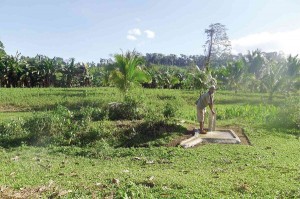Fresh water, life flow for Palaw-an tribe

A FAUCET seemingly in the middle of nowhere, actually for the use of around 50 households in Sitio Manggahan and Kininaman in Barangay Iraan, Rizal, at the foot of Mantalingajan. JAYMEE T. GAMIL
BATARAZA, Palawan—While most people equate water with life, it may also spell death for a tribe living off raw water sources in the Mantalingajan mountain range in southern Palawan.
In 2011, more than 30 Palaw-an tribe-folk, mostly children, in Bataraza and Rizal towns died, believed to have been from cholera triggered by contaminated mountain water.
Panglima Pulog Buntar, chieftain of the tribe living in Barangay (village) Bono-Bono in Bataraza, acknowledged the danger, speaking to the Philippine Daily Inquirer recently in halting Tagalog: “Before, a lot of us would get sick because of the dirty water, especially during the rainy season. Even when we’ve eaten nothing, our stomachs would hurt, leading to vomiting and defecating. Some would die within a day because of it.”
Last month, the line between life and death was finally drawn for Buntar’s poverty-stricken people, who live in a remote mountain more than a five-hour-drive and an hour’s trek away from Palawan’s capital city Puerto Princesa.
Two water pumps and water systems are now installed in the forests of Mantalingajan, coursing potable freshwater from hard-to-reach springs, and into newly constructed reservoirs, pipes and faucets in the mountain.
The project benefits around 80 tribal households scattered in Mantalingajan, not only in Bono-Bono but also in Sitios Manggahan and Kininaman in Barangay (village) Iraan in Rizal.
Water for water
The hydraulic ram pumps come care of the Coca-Cola Foundation Philippines, which seeks to install 100 of such water systems in remote communities, for their 100th anniversary in the country. The pumps in Mantalingajan bring the count to 23.
“We protect watersheds and give water to communities because water is important to us. It is the most important ingredient in every bottle of Coke. This is our way of giving back what we use up,” the foundation’s environment program officer Victor Manlapaz told the Palaw-an tribe in Filipino, during turnover ceremonies in their villages on Feb. 26 and 27. The foundation has set aside P600,000 to P2.2 million for each pump.
The “agos” (water flow) pumps require no electricity or fuel, using only the kinetic energy of flowing water to push water to an upland tank. The collected water is then piped down into faucets constructed in the community. The sustainable technology was designed by the Alternative Indigenous Development Foundation Inc. (AIDFI).
The project is coordinated by Earth Day Network Philippines (EDNP) and its partner Conservation International (CI), which takes care of the cultural reorientation that come with the pumps.
“We require beneficiaries to have a people’s organization to protect the pump and the watershed, and to have a solid waste management program,” EDNP trustee and program manager Binggirl Clemente explained.
In Mantalingajan, each of the 16 community tap stands also comes with a nearby latrine. “Because you may have water, but if it’s unclean, it’s useless,” Clemente underscored.
10 sick in a month
Or even dangerous. Seplon Chan, head of the community water association in Iraan, admits much of the “epidemic” in his village is caused by contaminated water: “The natives get their water from the [low-lying Itolos] river, but they also defecate there.”
Last year, at least 10 people per month got sick from waterborne bacterial diseases in Iraan, CI community facilitator Alvin Apostol said.
It can turn fatal. Cash and time-strapped, tribal folk tend to settle with ineffective herbal remedies, as it would take them an hour’s trek to go to the barangay (village) health center, or a whole day’s trek to get to a public hospital in the town proper.
The same problem of inaccessibility plagues the Palaw-An tribe in Bono-Bono. Before the ram pump was connected to the forested Amazon Spring in Mantalingajan, the villagers used to get water “from the next mountain” at least an hour’s trek away, Buntar says. Even then, the tribesfolk can carry only up to two gallons of water at a time.
This is why it was easy for the mountain settlers to agree to the ram pump project terms, which required them to provide the herculean construction labor and eventually take care of the facilities on their own.
More than water
But a more difficult requirement asks the Palaw-an folk to refrain from their age-old “kaingin” (slash-and-burn) farming. EDNP resident Robert Guevara cautions the tribe: “The ‘magic’ behind the pump is a strong water flow. When you cut down trees, you cut down the water.”
CI tries to dissuade the community from “kaingin” by providing livestock and agricultural livelihood. EDNP also teaches the tribe women to “upcycle” plastic and paper wastes into accessories for selling.
However, it would be easier said than done for the tribe, who largely relies on what little output they get from farming, yantok and resin-gathering, for small change.
In the end, whether the “new” water will bring life—or continue to spew death—would depend on the Palaw-an. “We need to come together on this. What is given should be accepted by all,” Buntar reminded the villagers. “We can no longer burn in the areas where the water comes from. We need to work together to protect the water.”














